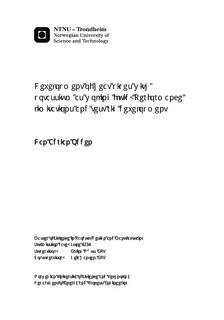| dc.contributor.advisor | Næss, Erling | nb_NO |
| dc.contributor.advisor | Hansen, Geir | nb_NO |
| dc.contributor.author | Odden, Dan Adrian | nb_NO |
| dc.date.accessioned | 2014-12-19T11:48:50Z | |
| dc.date.available | 2014-12-19T11:48:50Z | |
| dc.date.created | 2012-11-08 | nb_NO |
| dc.date.issued | 2012 | nb_NO |
| dc.identifier | 566114 | nb_NO |
| dc.identifier | ntnudaim:8178 | nb_NO |
| dc.identifier.uri | http://hdl.handle.net/11250/234774 | |
| dc.description.abstract | The incentive to reduce energy consumption in the industry is big, especiallyin high temperature systems. Heat pipes are of great interest for this purposedue to their favorable thermomechanical properties. This master thesis is apart of the ongoing study of Ph.D. candidate Geir Hansen, who is currentlydeveloping a rectangular heat pipe with potassium as working fluid at NTNU.The rectangular heat pipe is intended to be implemented in the walls ofelectrolysis cells as a part of a heat recovery system.The present work reports results of theoretical calculations of two importantheat transfer limitations, the incipience of boiling and the capillarylimitation for two types of nickel foam wicks. Results of experimental testscarried out on the cooling circuit for the proposed rectangular heat pipe arealso reported. The foam porosity, permeability and effective pore radius forwick 1 is 0.797, 31·10−12m2 and 62·10−6m, respectively, and for wick 2; 0.886,205·10−12m2 and 126·10−6m.A literature survey showed that porous coated surfaces improves the heattransfer and requires less superheat for boiling to commence. Calculationsperformed showed no danger of homogeneous nucleation in the proposed heatpipe. Boiling inside the nickel foam wick(s) were found to only be of concernfor wick 2 at high heat fluxes and a operating temperature of 600C.Calculations of the capillary limit showed that wick 2 is the best choicefor sustaining high heat fluxes. Increasing the wick length to 20cm madewick 2 not suitable for usage, and wick 1 was the best choice for increasedwick length. Combination of the two wick types showed to be very effectiveand significantly (factor of almost 4) improved the performance. An unevenheat flux distribution where a lower heat flux is at the bottom region of theevaporator is found to lower the performance, while a higher heat flux at thebottom region increases the performance.Early tests revealed that the PID controller was marginally stable, so thecontroller was tuned and stable operating conditions were achieved. Experimentsshowed that in order to get an accurate heat balance for the test rig,knowledge about the exact position of the thermocouples is needed. | nb_NO |
| dc.language | eng | nb_NO |
| dc.publisher | Institutt for energi- og prosessteknikk | nb_NO |
| dc.subject | ntnudaim:8178 | no_NO |
| dc.subject | MTPROD produktutvikling og produksjon | no_NO |
| dc.subject | Energi-, prosess- og strømningsteknikk | no_NO |
| dc.title | Development of heat pipes with potassium as woking fluid: Performance limitations and test rig development | nb_NO |
| dc.type | Master thesis | nb_NO |
| dc.source.pagenumber | 140 | nb_NO |
| dc.contributor.department | Norges teknisk-naturvitenskapelige universitet, Fakultet for ingeniørvitenskap og teknologi, Institutt for energi- og prosessteknikk | nb_NO |

